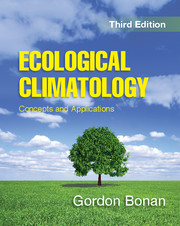Book contents
- Frontmatter
- Dedication
- Contents
- Preface
- 1 Ecosystems and Climate
- Part I The Earth System
- Part II Global Physical Climatology
- Part III Hydrometeorology
- 9 Soil Physics
- 10 Water Balance
- 11 Watershed Hydrology
- 12 Surface Energy Fluxes
- 13 Turbulent Fluxes
- 14 Soil Moisture and the Atmospheric Boundary Layer
- Part IV Biometeorology
- Part V Terrestrial Plant Ecology
- Part VI Terrestrial Forcings and Feedbacks
- Appendix
- Index
- Plate section
- References
13 - Turbulent Fluxes
from Part III - Hydrometeorology
Published online by Cambridge University Press: 05 November 2015
- Frontmatter
- Dedication
- Contents
- Preface
- 1 Ecosystems and Climate
- Part I The Earth System
- Part II Global Physical Climatology
- Part III Hydrometeorology
- 9 Soil Physics
- 10 Water Balance
- 11 Watershed Hydrology
- 12 Surface Energy Fluxes
- 13 Turbulent Fluxes
- 14 Soil Moisture and the Atmospheric Boundary Layer
- Part IV Biometeorology
- Part V Terrestrial Plant Ecology
- Part VI Terrestrial Forcings and Feedbacks
- Appendix
- Index
- Plate section
- References
Summary
Chapter Summary
The fluxes of sensible and latent heat occur because turbulent mixing of air transports heat and moisture, typically away from the surface. These fluxes are described in terms of transport by mean motion (a small term) and by turbulence (the dominant term). Turbulent transport is quantified by the covariance of temperature and moisture fluctuations with vertical velocity fluctuations. Turbulent fluxes of sensible heat, latent heat, and momentum are related to logarithmic profiles of temperature, water vapor, and wind near the surface. Monin–Obukhov similarity theory describes these profiles and fluxes in the surface layer of the atmosphere and is used to derive the aerodynamic conductances that regulate sensible and latent heat fluxes and an additional conductance for momentum. These conductances depend on roughness length and displacement height, which vary among land cover types. Aerodynamic conductances increase with taller (rougher) vegetation, all other factors being equal.
Turbulence
The exchanges of sensible and latent heat between land and atmosphere occur because of turbulent mixing of air and resultant heat and moisture transport. The flow of air can be represented as discrete parcels of air moving vertically and horizontally. These parcels have properties such as temperature, water vapor, and momentum (mass × velocity). As the parcels of air move, they carry with them their heat, water vapor, and momentum. Turbulence creates eddies that mix air from above downward and from below upward and transports heat and water vapor in relation to the temperature and moisture of the parcels of air being mixed (Figure 13.1). For example, air near the surface is generally warmer and moister than air above. Downward movements of air, therefore, tend to decrease temperature and water vapor while upward movements of air carry heat and moisture from the surface higher into the atmosphere.
- Type
- Chapter
- Information
- Ecological ClimatologyConcepts and Applications, pp. 209 - 217Publisher: Cambridge University PressPrint publication year: 2015
References
- 1
- Cited by



